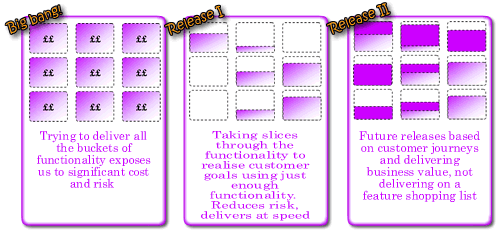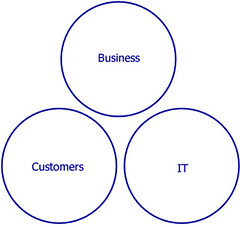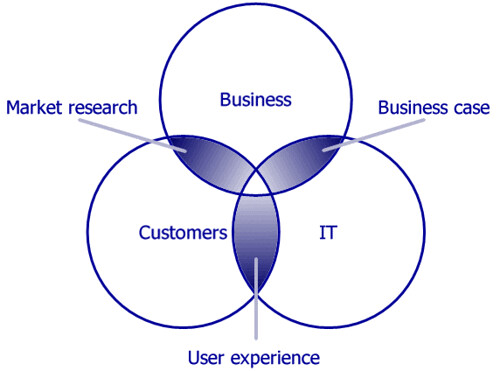Ditch the feature shopping list. Think customer journeys.
Let’s imagine a mobile phone provider that that has an on-line presence as well as a high street retail network. Their current website was built several years back on legacy technology; it is slow and has a conversion rate lower than industry norms. Along with having poor usability, the current shopping cart functionality does not support the concurrent usage figures that are hitting the site. The business takes the output from their web metrics and throw these at IT and demand improvements. And a new IT project is born. Rebuild the existing site on a new platform. They get a design agency to handle the look and feel. The functional requirements are built upon the existing functionality and chunked into functional silos:
- Content managed brochureware site
- Phone selection
- Tariff selection
- Shopping cart
- Order management
A typical project process. That is flawed. It is starting with a functional premise. An alternative is to think in terms of the customer and customer journeys.
We can start by asking who the customers are. Almost certainly the marketing department has a customer segmentation model – this is a good place to start. That may give us basic attitudinal and behavioural details on customers, but we need richer data. How do customers shop for phones? So we go and spend time in the stores and observe how people buy them. It soon becomes clear that the choose phone – choose tariff buy model is a journey that is only taken by a certain number of customers. Other customers come into the store with intentions – they don’t know what phone or tariff they want, but they know what they want a mobile phone for. Other customers come into the store asking lots of questions, they are doing research; they leave the store with the sales guy’s number, and costs for a couple of phones and tariffs. We look at the competition and see how they sell phones. We look at Amazon and eBay and expedia and see how other retailers sell products and experiences on the web. We synthesise our research and suddenly we have a whole bunch of new requirements. Gasp! Scope creep. Indeed if we list them out into functional silos again:
- Content managed brochureware site
- Lifestyler phone selection wizard
- Save a quote
- In-store quote save for on-line fulfilment
- On-line purchase for store fulfilment
- Phone selection
- Tariff selection
- Shopping cart
- Order management
- Etc
The business is excited and IT is despondent. When the business announce the date all this must go live by, the letters of resignation land on the IT directors desk and they start looking for contractors. It does have to be this way. You can have your cake and eat it.
Rather than thinking about vertical functional silos, we should think about horizontal slices through the functionality. Slices that support customer journeys. We can start with simple journeys to start and build complexity as we prove our process and new platform, mitigating technical risk as we progress.

The first release probably needs to demonstrate the new platform works: we can deliver on time; that a new shopping cart interfaces with our legacy warehouse order management system; etc. What’s the bare minimum we can do that does this and delivers business value. How about a microsite that sells a single product. Customers are directed to the microsite via a URL published on a flyer handed out in the stores.
As a customer who has picked up a special offer N80 deal flyer, I want to buy a Nokia N80 on a pay as you go contract
Our acceptance criteria:
Given I enter my personal details and credit card details When my credit card details are validated Then send order to warehouse to dispatch phone and activate contract.
We can decompose this requirement into discrete requirements, “stories” of sufficiently small size and estimate them. We’ll soon get a project velocity and because it is only a small release expectations, risks and dependencies will be easy to manage. We’ve not had to wait for months to get something out, everybody is happy.
We identify that a profitable segment of the market are the aspirationally clueless. People who want a mobile phone, realise they are a minority who don’t have one but are too afraid to admit they have no idea what they want. So we build a new customer journey.
As an aspirationally clueless I want say what I do and how I live my life and have a suitable phone selected for me.
OK, not the finest story, but you get the point. This story might take elements of the phone selection and tariff selection functional silos, but just enough to realise the required functionality. Because we are building around customer journeys, just enough to realise customer intentions that support those journeys we build only what is required. We are not building by feature list. We don’t over promise and under-deliver. We are building trust with all stakeholders. Surely this is the better way to build software, thinking about customer intentions and incrementally delivering to support more complex customer goals. Sadly, people all too often get fixated by feature lists. Because that is what they are used to. Because that is how products are sold. But isn’t there a marketing 2.0 where we sell experiences and go beyond the product. Isn’t that what Virgin does? But I’m probably off on a tangent.



